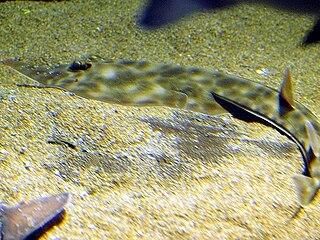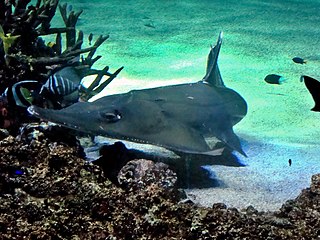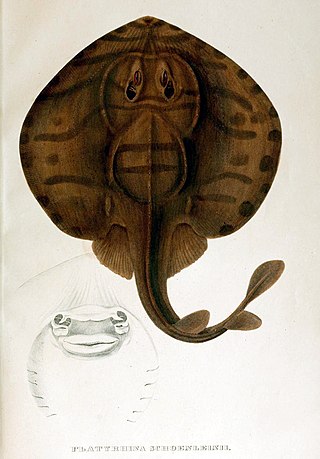
Myliobatiformes is one of the four orders of batoids, cartilaginous fishes related to sharks. They were formerly included in the order Rajiformes, but more recent phylogenetic studies have shown the myliobatiforms to be a monophyletic group, and its more derived members evolved their highly flattened shapes independently of the skates.

The guitarfish, also referred to as shovelnose rays, are a family, Rhinobatidae, of rays. The guitarfish are known for an elongated body with a flattened head and trunk and small, ray-like wings. The combined range of the various species is tropical, subtropical, and warm temperate waters worldwide.

Rhinobatos is a genus of fish in the Rhinobatidae family. Although previously used to encompass all guitarfishes, it was found to be polyphyletic, and recent authorities have transferred many species included in the genus to Acroteriobatus, Glaucostegus, and Pseudobatos.

The brown guitarfish is a species of fish in the Rhinobatidae family. It is found in western Pacific of Taiwan and the Philippines. Its natural habitats are open seas, shallow seas, coral reefs, and estuarine waters. The Taiwan guitarfish was formerly considered a distinct species, but is now considered a junior synonym.

The clubnose guitarfish(Glaucostegus thouin) is a critically endangered species of ray in the Glaucostegidae family. It is found from shallow coastal waters to a depth of 60 m (200 ft) in the Indo-Pacific, ranging from India to Southeast Asia, and also in the Red Sea. There are also old unconfirmed records from the Mediterranean and Suriname.

The common shovelnose ray, giant shovelnose ray or giant guitarfish is a species of fish in the Rhinobatidae family found in the central Indo-Pacific, ranging from India to the East China Sea, Solomon Islands and northern Australia. It is found in shallow coastal areas to a depth of at least 100 m (330 ft), including mangrove, estuaries and reportedly also in freshwaters. It reaches up to 2.7 m (8.9 ft) in length, and is greyish-brown to yellowish-brown above with a paler snout.

Rhynchobatus australiae, also called the white-spotted guitarfish, white-spotted wedgefish or bottlenose wedgefish, is a species of fish in the Rhinidae family. It is found from shallow waters to a depth of at least 60 m (200 ft) in the Indo-Pacific, ranging from the East African coast and the Red Sea, to Taiwan, the Philippines and Australia. It is part of a species complex that also includes the giant guitarfish, the broadnose wedgefish and possibly the smoothnose wedgefish.

The banded guitarfish, mottled guitarfish, prickly skate or striped guitarfish is a species of fish in the Trygonorrhinidae family. Originally Z. exasperata was placed in the Rhinobatidae family, however recent mitochondrial DNA analysis shows their placement into the new family of Trygonorrhinidae. They are found from shallow water to a depth of 200 m (660 ft) in the East Pacific from California, United States, to Mazatlan, Mexico, including the Gulf of California. The species has also been recorded further south, but this likely involves its close relative, the southern banded guitarfish.
Tarsistes philippii is a taxonomically dubious species of guitarfish, family Rhinobatidae. It is known only from a dried head from the Juan Fernández Islands off Chile. The head had a long, thin, flat snout, rounded at the tip like that of the goblin shark, and the underside covered with small stellate prickles except for the base. The head was covered with larger spinules, with six still larger ones forming a curve around the eye.

Wedgefishes are rays of the family Rhinidae, comprising eleven species in three genera. Classified in the order Rhinopristiformes along with guitarfishes and sawfishes, they have also been known as giant guitarfishes or sharkfin guitarfishes.

The halavi guitarfish is a part of the Glaucostegidae family. It is a species of ray found in the Indo-West Pacific. Recorded twice, in 1997 and 2004, in the levantine waters, the question of its permanent settlement in the Mediterranean Sea remains open. Its name is derived from the Arabic word حلاوي (halawi).

Rhinopristiformes is an order of rays, cartilaginous fishes related to sharks, containing shovelnose rays and allied groups.

Trygonorrhinidae, the banjo rays, is a family of rays, comprising eight species in three genera. They were formerly classified in the family Rhinobatidae.
The false shark ray is a species of fish in the Rhinidae family and the only species in the genus Rhynchorhina. This rare ray is only known from shallow coastal Atlantic waters in Banc d’Arguin, Mauritania.

The panrays are a genus, Zanobatus, of rays found in coastal parts of the warm East Atlantic Ocean, ranging from Morocco to Angola. It is the only genus in the family Zanobatidae, which traditionally has been included in the Myliobatiformes order, but based on genetic evidence it is now in Rhinopristiformes or a sister taxon to Rhinopristiformes.

Acroteriobatus is a genus of fish in the Rhinobatidae family. Although its constituent species were previously assigned to Rhinobatos, recent authors treat it as distinct.

Pseudobatos is a genus of fish in the Rhinobatidae family. Although its constituent species were previously assigned to Rhinobatos, recent authors treat it as distinct.















